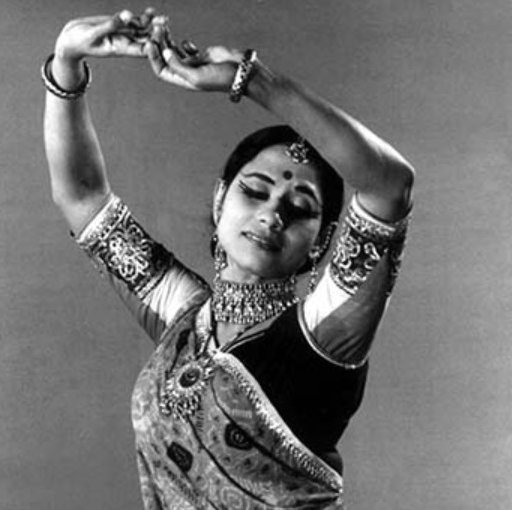 |
  |
 |
  |
A Dance Narrative Unbound In memory of Kumudini Lakhia (May 17, 1930 - April 12, 2025) - Dr. Chitra Sharma e-mail: sharmachitra8@gmail.com Photos courtesy: Kadamb May 9, 2025 As I witnessed the arts unfold in their abstract dreams, my very being was drawn into the silent struggle of understanding the tangible through the intangible. To rebel against tradition, to transgress limitations, to give birth to something original - beyond theory, beyond scripture - must have been an unimaginable journey, Kumiben. And such a journey was never meant to unfold within the confines of Delhi. You left because what you sought had no precedent in Kathak.  Your art, born of an insatiable desire for innovation, took root in the courtyard of experimentation. To reach its essence, I too had to traverse an inner path - one shaped by emotion, endurance, and insight. This journey marked a pioneering step: a bold movement to liberate dance from the strictures of form through abstraction. Whatever I have penned here remains a humble and incomplete tribute. Who, other than your spirit, could truly grasp the depth of this narrative? If only you were still among us. Kathak, with its rich, structured history, evolved within the sanctified realms of tradition and scripture. From solo renditions to group choreographies, it has transformed under the nuanced vision of gurus - yet largely remained within classical boundaries. But you, Kumiben, dared to dream beyond. That dream of abstraction - the dream of embodying the five elements - seen first by Raja Chakradhar Singh, found realization in your hands. Through rigorous artistic discipline and a radical reimagination of choreographic structure, you breathed new life into Kathak. You walked alone, echoing the spirit of Tagore's "Ekla chalo re," and in doing so, became a milestone in Kathak's history. Your lineage was rooted in tradition: trained by Guru Sohanlal of the Bikaner Gharana, Ashiq Hussain of Banaras, Sunder Prasad of Jaipur, and Shambhu Maharaj of Lucknow at Shriram Bharatiya Kala Kendra. This journey was made possible by your mother, Leela - herself a classical singer - whose liberated thinking envisioned a daughter unbound by social constructs, free to be an artist in her own right. Having studied the limitations of tradition, you returned to Ahmedabad, seeking an environment of quiet exploration. Here, you envisioned new dimensions in Kathak, armed with a free and experimental mind. You began with costume design - contributing to the film Gandhi, creating simple yet symbolic garments that defined the very image of Gandhi and Kasturba. This aesthetic minimalism left a lasting impression and became a signature of your Kathak as well.  Kumudini Lakhia and Pt Birju Maharaj You believed that the character on stage - male or female - should appear as real and unadorned as in life. This became the soul of your choreography: the inner abstraction of character, the emergence of the storyteller as a seer - the drashta. In doing so, you departed from traditional narration and offered the audience a new consciousness - where dance became a universal experience. Your choreographies - Okharn, Setu, Chakshu, Suvarna, Yugal, Dwidha, Kot, Samanvay, Vivarta, and Atah Kim - redefined Kathak for the modern mind. *In Dhabkar (1973), you captured the emotional landscape of a Kathak dancer. *Dwidha (1978) illustrated the internal conflict of a couple with poignant precision. *Atah Kim asked, "Where do I go from here?" - a cosmic dialogue where bodily grace met scientific imagination. *Samanvay brought 21 dancers into perfect harmony, revealing how spins, postures, and balances could become an effortless visual symphony. You broke conventions - in movement, costume, and ornamentation. The dupatta and jewelry that once restricted motion were abandoned. A radical act in Kathak's long tradition, it was initially met with harsh criticism - especially from Subbudu. But you responded not with defensiveness, but with deeper conviction. Your body bloomed in natural rhythm, your subtle sensuality lit up the stage, and your originality eventually won over even your fiercest critics. Gradually, the critical lens itself transformed. Art criticism evolved to embrace this asymmetrical storytelling - an aesthetic you internalized through your travels across 84 countries. Like Pandit Ravi Shankar, who brought abstraction into Indian music's global consciousness, you welcomed jazz, blues, dhrupad, folk, rock, Sufi, and even electronica into Kathak. Immersed in the emotional landscapes of ragas, you wove them into your abstract choreographies - creating a new language of expression. Your dancers painted the stage with movement - spins, pauses, and patterns becoming a grammar of visual poetry. This was the first time such experimental imagination appeared in Kathak - bold, yet never disconnected from tradition. This became the cornerstone of what we now call modern Kathak. You reimagined the guru-shishya dynamic - not as one of subservience, but of equality. You empowered your students to grow beyond you. "What you now create on stage is yours," you told them. "Take responsibility for it." Your creative genius reached the silver screen in Umrao Jaan. Your choreography, paired with Rekha's unforgettable portrayal, elevated Umrao into an icon. The haunting grace of "In aankhon ki masti ke..." owes its timelessness to your vision.  Kumiben in a dance pose You were a thinker of rare originality. Your words echo in memory: "Every emptiness (space) is a place filled with dormant energy - longing to take form." "Within empty spaces, there are shapes and patterns born from my life, Where the body becomes larger than life, and space becomes flexible. Time and space begin a conversation." And in that sacred conversation between time and space - there stood Kumiben. You once said: "I don't do this so people will call me experimental or innovative. I see myself in Kathak. My dance is who I am." This humility - this merging of identity and art - defined your legacy. You moved away from mythological themes like Radha-Krishna or Shiva-Parvati. Instead, you ventured into unseen, sensual, and spiritual narratives. You gave form to the invisible, shaped by lived experience and inner vision. In your world, life was not physical - it was conscious. Your dance, thus, took on a cosmic dimension. Kumiben, you reflected your inner universe - and in doing so, you changed ours.  Dr Chitra Sharma is an art critic. She has her own YouTube Channel and a page on Face Book named "Kathak ka soundarya." She is working with CBC, information and broadcasting ministry as an assistant director (programmes). * Thank you from a proud son-in-law. Your article embodies her thinking through her body of work! (May 11, 2025) Post your comments Please provide your name and email id along with your comment. All appropriate comments posted with name and email id in the blog will also be featured in the site. |